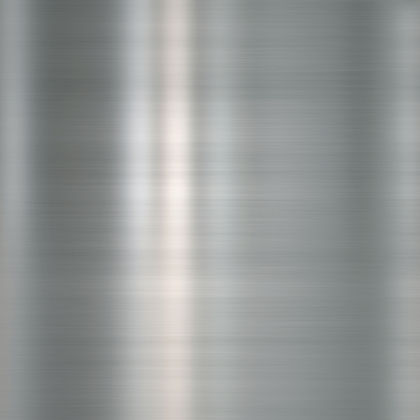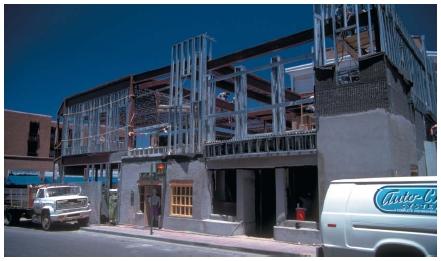Aluminum family

The aluminum family consists of elements in Group 13 of the periodic table: boron (B), aluminum (Al), gallium (Ga), indium (In), and thallium (Tl). The family is usually named after the second element, aluminum, rather than the first, boron, because boron is less typical of the family members than is aluminum. Boron is a metalloid (an element that has some of the properties of metals and some of the properties of nonmetals), while the other four members of the family are all metals.
Aluminum
Aluminum is a lightweight, silvery metal, familiar to every household in the form of pots and pans, beverage cans, and aluminum foil. It is attractive, nontoxic, corrosion-resistant, nonmagnetic, and easy to form, cast, or machine into a variety of shapes. It has a melting point of 660°C (1,220°F) and a boiling point of 2,519°C (4,566°F).
Aluminum is the third most abundant element in Earth's crust after oxygen and silicon, and it is the most abundant of all metals. It constitutes 8.1 percent of the crust by weight and 6.3 percent of all the atoms in the crust. Because it is a very active metal, aluminum is never found in its metallic form. Rather, it occurs in a wide variety of earthy and rocky minerals, including feldspar, mica, granite, and clay. Kaolin is an especially fine, white, aluminum-containing clay that is used in making porcelain.
Known as aluminium in other English-speaking countries, the element was named after the mineral alum, one of its salts that has been known for thousands of years. Alum was used by the Egyptians, Greeks, and Romans as a mordant, a chemical that helps dyes stick to cloth.
Properties and uses. Pure aluminum is relatively soft and not the strongest of metals. When melted together with other elements such as copper, manganese, silicon, magnesium, and zinc, however, it forms alloys (a substance composed of two or more metals or of a metal and a nonmetal) with a wide range of useful properties. Aluminum alloys are used in airplanes, highway signs, bridges, storage tanks, and buildings. The world's tallest buildings, the World Trade Center towers in New York, are covered with aluminum. Aluminum is being used more and more in automobiles because it is only one-third as heavy as steel and therefore decreases fuel consumption.
In spite of the fact that aluminum is chemically very active, it does not corrode in moist air the way iron does. Instead, it quickly forms a thin, hard coating of aluminum oxide. Unlike iron oxide or rust, which flakes off, the aluminum oxide sticks tightly to the metal and protects it from further oxidation. The oxide coating is so thin that it is transparent, so the aluminum retains its silvery metallic appearance. Sea water, however, will corrode aluminum unless it has been given an unusually thick coating of oxide by the anodizing process. (During the anodizing process, a piece of aluminum is oxidized in order to create on its surface a coating of aluminum oxide, which is able to take dyes, unlike plain aluminum.)
When aluminum is heated to high temperatures in a vacuum, it evaporates and condenses onto any nearby cool surface such as glass or plastic. When evaporated onto glass, it makes a very good mirror. Aluminum has largely replaced silver in the production of mirrors because it does not tarnish and turn black as silver does when exposed to impure air. Many food-packaging materials and shiny plastic novelties are made of paper or plastic with an evaporated coating of bright aluminum. The silver-colored helium balloons popular at birthday parties are made of a tough plastic called Mylar™, covered with a thin, evaporated coating of aluminum metal.
Aluminum is one of the best conductors of electricity, with a conductivity about 60 percent that of copper. Because it is also light in weight and highly ductile (able to be drawn out into thin wires), it is used instead of copper in almost all of the high-voltage electric transmission lines in the United States.
Aluminum is used to make kitchen pots and pans because of its high heat conductivity. It is handy as an airtight and watertight food wrapping because it is very malleable; it can be pressed between steel rollers to make foil (a thin sheet) less than one-thousandth of an inch thick. Claims are occasionally made that aluminum is toxic and that aluminum cookware is therefore dangerous, but no clear evidence for this belief has ever been found. Many widely used over-the-counter antacids contain thousands of times more aluminum (in the form of aluminum hydroxide) than a person could ever get from eating food cooked in an aluminum pot. Aluminum is the only light element that has no known physiological function in the human body.
Production. As a highly reactive metal, aluminum is very difficult to separate from other elements that are combined with it in its minerals and compounds. In spite of its great abundance on Earth, the metal itself remained unknown for centuries. In 1825, some impure aluminum metal was finally isolated by Danish physicist Hans Christian Oersted (1777–1851) by treating aluminum chloride with potassium amalgam (potassium dissolved in mercury). Then, in 1827, German chemist Hans Wöhler (1800–1882) obtained pure aluminum by the reaction of metallic potassium with aluminum chloride. He is generally given credit for the discovery of elemental aluminum.
But it was still very expensive to produce aluminum metal in any quantity, and for a long time it remained a rare and valuable metal. In 1852, aluminum was selling for about $545 a pound. The big breakthrough came in 1886, when Charles M. Hall, a 23-year-old student at Oberlin College in Ohio, and Paul L-T. Héroult, another college student in France, independently invented what is now known as the Hall or Hall-Héroult process. This process consists of dissolving alumina (aluminum oxide) in melted cryolite, a common aluminum-containing mineral, and then passing an electric current through the hot liquid. Molten aluminum metal collects at the cathode (negative electrode). Not long after the development of this process, the price of aluminum metal plummeted to about 30 cents a pound. The process used to extract aluminum from its ores today is essentially the same as that developed by Hall and Héroult 150 years ago.
Boron
Elemental boron occurs in a variety of forms, ranging from clear red crystals to a black or brown powder to a transparent black crystal that is nearly as hard as diamond. The element is never found free in nature but is extracted commercially from minerals such as borax, ulexite, colemanite, and kernite. Boron is a relatively rare element, constituting about 0.001 percent of Earth's crust. It ranks number 38 in abundance, after nitrogen, lithium, and lead, but before bromine, uranium, and tin.
Properties and uses. The physical properties of boron are somewhat difficult to determine since the element occurs in so many different forms. The melting point of its most stable form is given as 2,180°C (3,900°F) (the second highest after carbon); its boiling point is about 3,650°C (6,600°F).
Chemically, boron is a fascinating element. One text on the chemical elements claims that the inorganic chemistry of boron is "more diverse and complex than that of any other element in the periodic table." The element forms five types of compounds: (1) metal borides (a metal plus boron), (2) boron hydrides (boron plus hydrogen), (3) boron trihalides (boron plus a halide; a halide is a simple halogen compound), (4) oxo compounds (boron plus complex oxygen radicals; a radical is a group of atoms that behaves as a unit in chemical reactions but is not stable except as part of the compound), and organoboron compounds (boron combined with an organic, or carbon-containing, component).
Boron itself has relatively few uses aside from its role in nuclear reactors as a neutron absorber and in alloys as a hardening agent. (Nuclear reactors are devices used to control the energy released from nuclear reactions.) It is also used in the manufacture of semiconductors. (Semiconductors are substances that conduct an electric current but do so very

poorly.) Probably its best known compound, borax, is used as a water softening agent, in the production of glasses and ceramics, and as an herbicide. A compound derived from borax—boric acid—is used as an eyewash and in the production of heat-resistant glass.
Two boron compounds of special interest are boron carbide and boron nitride. Both are used as refractories, substances that are highly resistant to heat. The melting point of boron carbide is about 2,350°C (4,230°F) and that of boron nitride, over 3,000°C (5,400°F). When boron nitride powder is compressed at very high pressures, it produces a hard crystalline material that is as hard as natural diamonds.
Gallium, indium, and thallium
For most of its history, gallium was best known for one unusual physical property: it has a melting point of 29.76°C (85.6°F), less than that of the human body. If you were to hold a lump of gallium metal in your hand, therefore, it would melt.
In spite of this fact, gallium and its compounds have traditionally had few uses—until recently. In the 1970s, a compound of gallium called gallium arsenide was found to have semiconductor properties. Gallium arsenide has also been used extensively in light-emitting diodes (LEDs), which are used in the electronic displays of calculators, watches, and CD players.
Neither indium nor thallium has many commercial applications. The former element is used largely in making alloys and in the production of transistors and photo cells. A radioactive isotope of the latter, thallium-201, is used in medical diagnostic studies, especially those involving the function of the circulatory system.
[ See also Periodic table ; Transistor ]